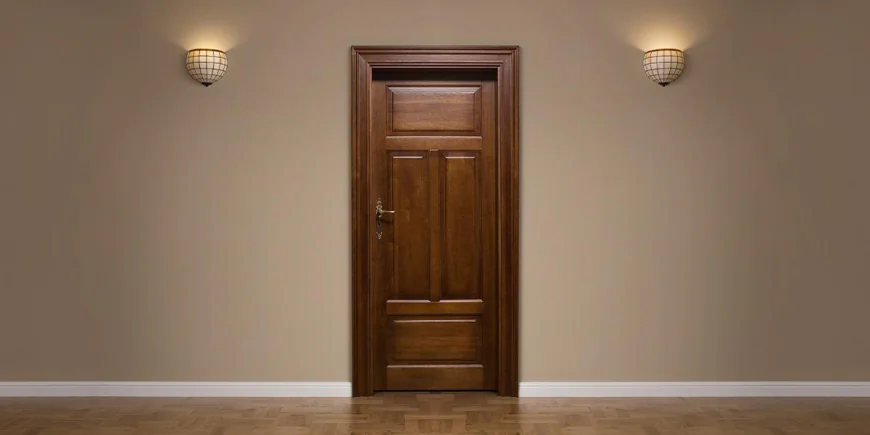Wooden doors can add an elegant touch to any home. Whether you're installing a sleek flush door in your living room or a more durable door for the bathroom, wooden doors are versatile and fit seamlessly into various spaces.
However, if you live in a humid climate, you’ll need to take extra care to preserve the condition of these doors.
Humidity can cause wooden doors to warp, swell, and even rot, especially in moisture-prone areas like kitchens or bathrooms. Luckily, with some simple maintenance and thoughtful choices, you can protect your wooden doors and extend their lifespan.
Here are some practical tips for keeping your doors, including those in the kitchen and bathroom, in great shape:
1. Pick the Right Type of Wood for Different Spaces
When choosing a wooden door, it’s important to select the right type of wood, particularly for rooms exposed to high humidity. Hardwoods like oak, teak, or mahogany are ideal choices for areas that experience moisture because they are dense and naturally more resistant to swelling or warping. For example, a
flush door made from these hardwoods will hold up better than one made from softer woods like pine.
For specific areas like bathrooms and kitchens, where humidity is a constant concern, opt for wood types that are naturally resistant to moisture. Alternatively, you can go for waterproof doors or doors treated with moisture-resistant finishes. These kinds of doors are perfect for areas that frequently face water exposure. If you're renovating or replacing doors in high-moisture areas, consider these options to keep your doors functional and looking good over time .
2. Seal and Finish the Wood to Prevent Moisture Damage
Wooden doors are porous, which means they can absorb moisture from the air. Without proper protection, this moisture can cause your door to swell, warp, or even rot. This is especially important for doors for the bathroom or kitchen doors, where humidity levels are typically higher.
To protect your doors, apply a good-quality sealer or finish. This creates a protective barrier that prevents moisture from penetrating the wood. Make sure to choose a sealer or finish designed for exterior or high-humidity areas. When applying, cover all parts of the door, including edges and joints, as these areas are more prone to water absorption. If you notice the finish starting to fade or peel, it’s time to reapply to maintain the door’s protection.
3. Maintain Proper Ventilation Around the Door
One simple but effective way to maintain wooden doors, especially in areas with high humidity, is to ensure proper ventilation. Without good airflow, moisture can accumulate around your wooden doors, which may cause them to absorb excessive moisture and warp. This is particularly important in rooms like kitchens, bathrooms, or basements where humidity can fluctuate more frequently.
Keep your living spaces well-ventilated by opening windows or using fans to encourage air circulation. In rooms like the bathroom or kitchen, consider installing an exhaust fan or using a dehumidifier. These steps will help reduce the humidity in the air and prevent the wooden door from absorbing too much moisture.
4. Regularly Clean and Inspect the Door
One of the simplest ways to care for your wooden doors is by cleaning them regularly. Dust and dirt can accumulate on the door’s surface, trapping moisture and potentially leading to mold or mildew growth. A clean door not only looks better but also prevents moisture buildup that can damage the wood.
For cleaning, use a soft cloth or sponge with mild soap and water. Avoid harsh chemicals or abrasive cleaning tools, as these can damage the wood or its finish. After cleaning, dry the door with a clean towel to make sure no water is left behind. Also, take a moment to inspect the door for signs of wear, such as cracks, peeling paint, or areas where moisture might have gotten in. If you spot any issues, address them quickly to avoid further damage.
5. Protect the Door with a Storm Door or Overhang
To safeguard your wooden doors, especially those on the exterior, consider installing a storm door or an overhang. These protective layers shield your door from rain, snow, and direct exposure to the elements, which helps reduce the impact of moisture on the wood.
A storm door can also help with insulation and energy efficiency, keeping your home comfortable in different seasons.
If a storm door isn’t an option, you can still protect your door by installing a simple overhang or awning above it. This will help keep rainwater off your door for the bathroom or kitchen doors, preventing direct exposure to moisture. Even just a small overhang can go a long way in maintaining the integrity of the door.
6. Use a Dehumidifier in Humid Rooms
In particularly humid areas of your home, like bathrooms or kitchens, it’s worth investing in a dehumidifier. Dehumidifiers work by removing excess moisture from the air, helping to keep the environment dry and preventing your wooden doors from absorbing too much moisture. This is particularly helpful in areas where humidity levels are constantly high.
Placing a dehumidifier in rooms with wooden doors can help protect the doors from swelling or warping.
This can also help prevent mold growth and keep your doors looking new for longer. Just be sure to empty the dehumidifier regularly to ensure it continues to work effectively.
Wrapping Up
Maintaining your wooden doors, especially in humid climates, doesn’t have to be complicated. By following these seven simple tips, you can protect your flush doors, doors for the bathroom, kitchen doors, and other wooden doors in your home.
Start by
choosing the right type of wood for your environment, sealing the door to prevent moisture damage, and ensuring proper ventilation around it. Regular cleaning, adding protective barriers like storm doors, and using a dehumidifier will all help keep your doors in top condition.





















.webp)

























.webp)
























.webp)







.jpeg)


































